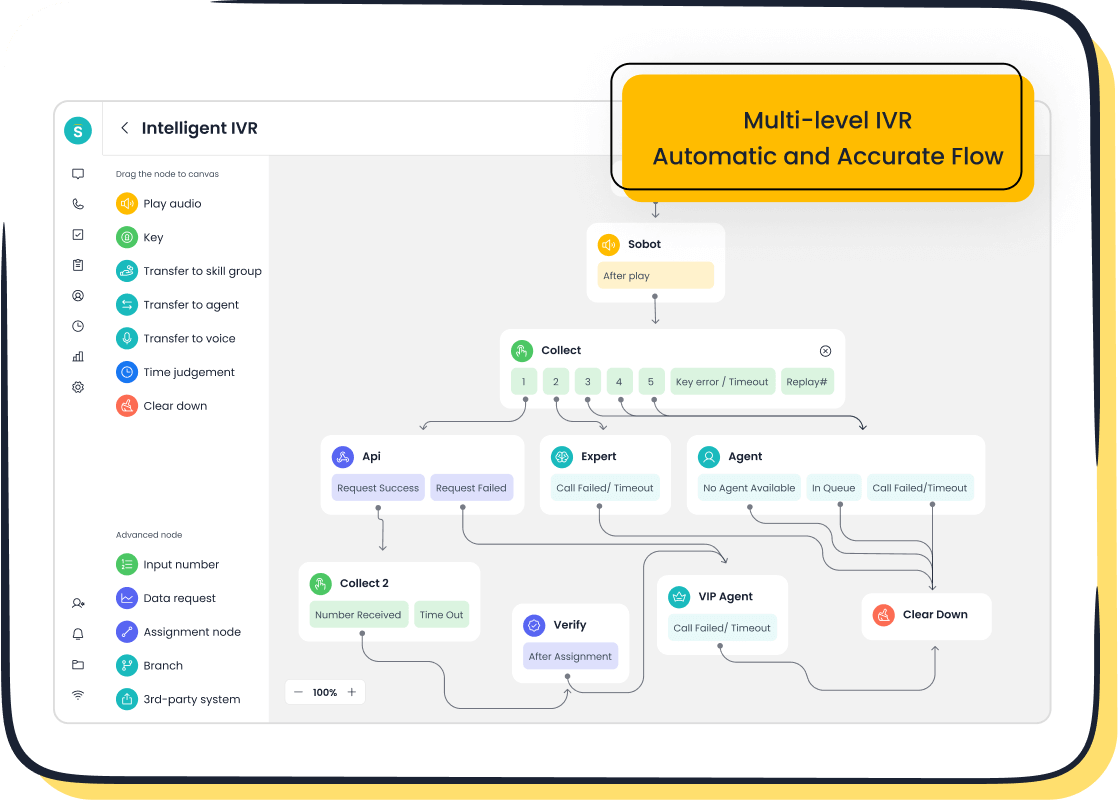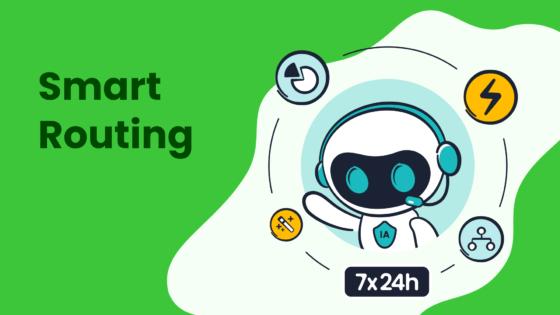A Beginner’s Guide to Omni Channel Contact Center Solutions

An omni channel contact center solution connects all channels, such as phone, chat, email, and social media, into one platform. This approach helps businesses deliver a smooth customer service experience. Companies like Sobot use advanced technology to support diverse industries, from retail to healthcare. Studies show that unified communication boosts customer satisfaction and loyalty by making every customer interaction seamless. The market for omnichannel contact center solutions keeps growing, as shown below:
| Metric/Segment | Value/Projection |
|---|---|
| Market size (2022) | USD 28.09 billion |
| Market size (2023 estimate) | USD 33.38 billion |
| Compound Annual Growth Rate | 23.9% (2023-2030) |
| Market size (2030 projection) | USD 149.58 billion |
Omnichannel solutions help companies like Sobot AI and Sobot call center create better experiences for every customer.

What Is an Omnichannel Contact Center?

Core Concept
An omnichannel contact center is a modern approach to customer service. It brings together all communication channels—such as phone, email, chat, social media, and messaging apps—into one unified platform. This integration allows businesses to manage every customer interaction in a single place. According to industry experts, an omnichannel contact center synchronizes and connects these channels so customers can switch between them without losing context. Agents see the full history of each customer’s interactions, which helps them provide faster and more accurate support.
An omnichannel contact center uses a cloud-based system to combine all customer communications. This system gives agents access to real-time and historical data, making it easier to personalize each customer experience.
The main components of an omnichannel contact center include:
- A unified, cloud-based platform that manages all customer interactions.
- Seamless integration of multiple communication channels, including APIs for existing tools.
- Personalized customer experiences using real-time and historical data.
- Intelligent routing of requests based on agent skills, priorities, and AI chatbots.
- Self-service options like automated call routing and FAQs.
- Analytics and reporting to track performance and satisfaction.
- High security and system uptime, including encryption and two-factor authentication.
These features work together to create a smooth and efficient customer service experience. Businesses can respond to customers on their preferred channels, whether that is a phone call, a chat message, or a social media post. This flexibility improves both agent productivity and customer satisfaction.

Sobot provides a leading omni channel contact center solution that covers all these core components. Sobot’s platform supports voice, chat, email, and social media, all in one place. The system uses AI-powered chatbots and smart routing to handle requests quickly. Sobot also offers a unified workspace for agents, making it easy to manage every customer interaction. With a 99.99% uptime and secure data transfer, Sobot ensures reliable and safe communication for businesses of all sizes.
Unified Customer Experience
A true omnichannel contact center delivers a unified customer experience. This means customers receive consistent, personalized support no matter which channel they use. Agents can see the entire history of each customer’s interactions, so customers never have to repeat themselves. This approach saves time and reduces frustration for both customers and agents.
Omnichannel contact centers use cloud-based software to bring all communication channels together. Agents can review complete interaction histories and switch between channels during live conversations. AI and automation help optimize workflows, allowing agents to focus on complex issues while chatbots handle simple requests. Real-time syncing across voice and digital channels ensures agents always have the full context.
For example, a customer might start a conversation through a website chat, then switch to a phone call. The agent can see the chat history and continue helping the customer without missing any details. This seamless transition builds trust and improves the overall customer experience.
According to industry data, 70% of customers expect agents to know their full situation when they reach out for support. Omnichannel contact centers meet this expectation by giving agents a unified view of all past interactions.
Sobot’s omni channel contact center solution helps businesses achieve this unified experience. The platform integrates voice, chat, email, and social media, so agents can access all customer data in one place. Sobot’s AI-driven chatbots provide 24/7 support, while the unified workspace ensures agents always have the information they need. This setup leads to faster response times, higher satisfaction, and stronger customer relationships.
Real-World Example: Opay’s Omnichannel Success
Opay, a leading financial service platform, faced challenges managing customer interactions across multiple channels. The company needed a way to streamline customer service and marketing efforts. By implementing Sobot’s omnichannel contact center, Opay unified its social media, email, and voice channels into a single system.
- Opay’s customer satisfaction rate increased from 60% to 90%.
- Operational costs dropped by over 20%.
- Conversion rates rose by 17%.
Sobot’s solution allowed Opay to manage all customer inquiries efficiently. The intelligent IVR system enabled 60% of customers to resolve issues on their own. The WhatsApp Business integration achieved an 85% message reading rate, boosting marketing outreach. Opay’s experience shows how an omnichannel contact center can transform customer service and drive business results.
Other companies have seen similar benefits. For example, organizations in retail and e-commerce use omnichannel solutions to provide support through social media, email, and chat. This approach leads to faster responses and higher customer satisfaction. In education and gaming, agents use unified platforms to address inquiries more effectively, improving the overall experience for students and players.
Omnichannel contact centers help businesses deliver seamless, consistent, and personalized customer experiences across all channels. This unified approach builds loyalty and sets companies apart in today’s competitive market.
Sobot’s omni channel contact center solution stands out by offering advanced features like AI chatbots, unified agent workspaces, and easy integration with existing systems. These tools help businesses of all sizes improve customer engagement, reduce costs, and boost satisfaction.
Omnichannel vs. Multichannel
Key Differences
Businesses often choose between omnichannel and multichannel contact center models to manage customer service. Both approaches use multiple communication channels, but they work in very different ways. The main difference is how these channels connect and share information.
The table below shows the key differences:
| Feature | Omnichannel Contact Center | Multichannel Contact Center |
|---|---|---|
| Channel Integration | Channels are fully integrated, sharing data and context across all touchpoints. | Channels operate independently, with no data sharing between them. |
| Customer Experience | Provides a unified, seamless, and personalized journey across all channels. | Experiences can be disjointed; customers may need to repeat information. |
| Data Sharing | Customer data and history are shared for continuity. | Data is isolated per channel, leading to loss of context. |
| Personalization | Enables hyper-personalized service using full customer insights. | Limited personalization due to lack of integrated data. |
| Agent Productivity | Agents access unified data, reducing time spent switching tools. | Agents work with separate platforms, requiring more effort. |
Omnichannel contact centers use advanced, cloud-based systems to connect all communication channels. This integration allows agents to see the full customer journey and respond quickly. Multichannel centers offer several channels, but each one works alone. Customers may have to repeat their information when they switch channels, which can cause frustration.
Omnichannel communication helps businesses deliver a consistent and efficient customer service experience. It supports stronger customer loyalty and higher satisfaction.
Customer Journey
The customer journey in an omnichannel contact center is smooth and connected. Customers can start a conversation on one channel, like live chat, and continue it on another, such as phone or email. Agents see the entire interaction history, so customers never need to repeat themselves. This seamless experience builds trust and saves time.
In a multichannel setup, each channel stands alone. If a customer starts with an email and then calls, the agent may not know about the earlier email. This can lead to repeated questions and slower problem-solving.
- Omnichannel contact centers connect all communication channels, allowing agents to share notes and access full customer history.
- Customers receive a consistent, personalized, and efficient experience, which increases satisfaction and loyalty.
- Multichannel centers offer multiple channels but without integration, leading to fragmented journeys and possible frustration.
Sobot’s omnichannel contact center solution gives agents a unified workspace. They can view all customer interactions in one place, making it easier to provide fast and accurate support. This approach improves agent productivity and helps businesses meet modern customer expectations.
Companies that switch from multichannel to omnichannel communication often see higher customer satisfaction and better business results. Automation and AI in omnichannel systems can reduce manual process costs by up to 30% (McKinsey).
Omnichannel contact centers help businesses stay competitive by delivering seamless, personalized service across all communication channels.
Benefits of Omnichannel Contact Center Solutions
Customer Satisfaction
Omnichannel contact center solutions help businesses improve customer satisfaction in many ways. Customers want fast answers and do not like repeating themselves. When companies use an omnichannel contact center, agents see the full history of every customer interaction. This makes it easier to solve problems quickly and provide personalized support. Studies show that every 1% increase in first call resolution can boost customer satisfaction by up to 5%. Companies like Opay saw their satisfaction scores rise from 60% to 90% after switching to Sobot’s omnichannel platform. Real-time analytics and AI-powered automation also help agents respond faster and more accurately, leading to better customer experiences and higher retention.
Omnichannel customer service gives customers the freedom to choose their favorite communication channels, making every experience smooth and enjoyable.
Efficiency and Productivity
Omnichannel solutions increase efficiency and productivity for both agents and customers. Agents work in a unified workspace, so they do not waste time switching between tools. Self-service options, such as AI chatbots and automated IVR, let customers solve simple issues on their own. This reduces the number of calls agents must handle and lowers operational costs. Metrics like average handle time, agent utilization rate, and self-service success rate all improve with an omnichannel contact center. Sobot’s platform, for example, helps businesses reduce average handle time and increase first contact resolution. Automation and regular training also help agents perform better and adapt to changing customer needs.
Consistency Across Channels
Consistency is key to building trust and loyalty. An omnichannel contact center brings all communication channels together in one place. Customers can switch from chat to phone or email without losing context. Agents always have access to the full interaction history, so customers never need to repeat information. This unified approach keeps messaging, tone, and service quality the same across all channels. Sobot’s omnichannel solution uses unified dashboards and CRM integration to make sure every customer receives reliable and professional support. This consistency leads to stronger brand loyalty and a better overall customer experience.
Essential Features of Omnichannel Contact Center Software

Unified Workspace
A unified workspace stands at the core of effective omnichannel contact center software. This feature brings all customer interactions from different channels—such as voice, chat, email, and social media—into one easy-to-use interface. Agents can see real-time customer details, conversation history, and CRM data without switching between applications. This setup helps agents respond faster and provide more personal support. For example, Sobot’s omnichannel cloud contact centers offer a unified workspace that lets agents manage calls, messages, and tickets in one place. This reduces agent frustration and speeds up training for new team members. With all information visible, agents resolve issues quickly and improve the customer experience.
AI and Automation
AI and automation play a big role in modern omnichannel contact center software. AI-driven chatbots and virtual assistants handle routine questions, giving customers self-service options day and night. These tools use natural language processing to understand requests and provide instant answers. Automation also helps with intelligent routing, sending each inquiry to the right agent based on skill or urgency. Sobot’s software uses AI customer service features to boost agent productivity and reduce wait times. Predictive analytics help agents anticipate customer needs and offer proactive support. AI tools also provide real-time suggestions, making it easier for agents to solve complex problems. This combination leads to higher first-contact resolution and better service quality.
Integration and Analytics
Seamless integration with CRM and business systems is a must for omnichannel cloud contact centers. This feature gives agents a complete view of customer data, including past interactions and preferences. Sobot’s omnichannel solution connects with popular platforms like Salesforce and Shopify, making workflows smoother. Analytics tools in the software track key metrics such as response times, customer satisfaction, and agent performance. Real-time and historical reports help managers spot trends and make data-driven decisions. These insights support continuous improvement and help businesses scale their operations. Self-service options, like AI-powered chatbots, also generate valuable data for analytics, helping companies refine their service strategies.
Tip: Omnichannel contact center software with strong integration and analytics can increase sales revenue by up to 7% and boost profitability by 2% (McKinsey).
Getting Started with Omnichannel Contact Center Solution
Assessment and Planning
Starting with an omnichannel contact center solution begins with careful assessment and planning. Companies need to understand how their customers interact with them. Mapping the customer journey helps identify which channels customers prefer, such as phone, chat, or social media. By analyzing customer interaction data, businesses can spot patterns and pain points. This step supports customer experience management and helps set clear goals for the new system.
Teams should gather feedback from agents early. Agents know where current processes slow down and what training they need. Reviewing data on channel performance and customer satisfaction gives a clear picture of what works and what needs improvement. Companies should define measurable goals, such as reducing customer effort or improving agent efficiency. These goals guide the entire omnichannel strategy.
Strategic planning also means aligning teams across the business. Customer service, marketing, and IT must work together. This alignment ensures consistent messaging and a smooth transition to the new software. Planning is not a one-time event. Companies should keep reviewing their strategies as customer needs change.
Tip: Start with a phased approach. Begin by improving the most-used channel, then add others like chat or email. This reduces risk and helps teams adjust step by step.
Implementation Steps
Implementing an omnichannel contact center solution involves several key steps. Here is a simple guide for beginners:
- Assess Current Systems: Identify gaps in service and document how each channel performs. Look at customer satisfaction scores and agent feedback.
- Set Clear Goals: Decide what the business wants to achieve, such as higher customer satisfaction, better retention, or faster response times.
- Choose the Right Software: Select a solution that integrates all channels into one interface. Sobot’s omnichannel software, for example, connects voice, chat, email, and social media, making it easy for agents to manage every interaction.
- Plan Technology Integration: Make sure the new software connects with existing CRM systems and supports AI-powered automation. Sobot’s platform offers seamless integration with tools like Salesforce and Shopify.
- Train Agents: Provide role-specific training so agents can use the new tools confidently. Training should cover both technical skills and soft skills, such as communication and problem-solving.
- Enable Self-Service Options: Set up AI chatbots and knowledge bases to let customers solve simple issues on their own. Sobot’s AI-powered chatbots provide 24/7 support and automate routine tasks.
- Monitor and Optimize: Use analytics to track key metrics like first-contact resolution and customer satisfaction. Adjust strategies based on real-time data.
Sobot supports businesses through every step. The company offers onboarding, technical support, and regular updates. Their team helps with agent training and provides resources like FAQs and best practices. This support ensures a smooth transition and ongoing success.
Note: Over 45% of firms using Sobot’s omnichannel solutions report better customer engagement, and 35% see improved retention and loyalty.
Best Practices
Successful adoption of omnichannel software depends on following proven best practices. Companies should map the customer journey to find all touchpoints and interactions. This helps pinpoint where integration is most needed. Investing in a unified platform, like Sobot’s, brings all communication channels together in one agent interface.
Agent training is critical. Agents must learn to manage conversations across multiple channels at once. Consistent service standards help maintain quality. Monitoring key performance indicators, such as response times and resolution rates, ensures uniform service.
AI-powered automation can handle routine questions, freeing agents to focus on complex issues. Sobot’s software uses AI to automate over 40% of routine tasks, which boosts productivity and allows teams to focus on higher-value activities. Real-time analytics and reporting tools give managers insights to improve service quality.
Companies should foster a culture of continuous improvement. Customer feedback and performance data help refine processes. Recognizing the contact center as a strategic asset, not just a problem-solving department, leads to better customer experiences and stronger loyalty.
Companies with strong omnichannel engagement retain 89% of their customers, showing the value of these best practices (source).
Overcoming Challenges
Organizations often face challenges when moving to an omnichannel contact center. Common issues include data silos, inconsistent service quality, and scaling operations. The table below shows some challenges and strategies to overcome them:
| Challenge | Description | Strategy to Overcome |
|---|---|---|
| Data Silos and Fragmentation | Isolated data across channels | Unified data management for a complete customer view |
| Maintaining Consistent Quality | Different demands per channel | Advanced monitoring and quality assurance tools |
| Scaling Operations | Growing customer interactions | Scalable, cloud-based infrastructure |
| Integrating Advanced Technologies | Balancing AI with human touch | Harmonious integration of AI and human agents |
| Staff Training and Skill Development | Agents need versatile skills | Ongoing, comprehensive training |
| Organizational Alignment | Breaking down silos between teams | Collaborative culture and shared goals |
| Process Inefficiencies | Lack of standardized processes | Define and document key processes |
Sobot’s omnichannel software addresses these challenges with unified data management, advanced analytics, and scalable cloud infrastructure. The platform supports agent training with tailored modules and provides ongoing support. Sobot’s AI tools automate routine tasks, helping agents focus on complex customer needs.
Ongoing optimization is essential for long-term success. Real-time analytics and conversational intelligence give immediate insights into customer interactions. Sobot’s software empowers agents to adapt quickly, ensuring personalized and consistent experiences. Continuous use of these tools helps businesses remain agile and improve both agent performance and customer satisfaction.
Companies using Sobot’s omnichannel solutions save up to 2.5 billion hours annually through AI-powered automation. This efficiency supports business growth and long-term customer loyalty.
Omnichannel contact center solutions transform customer service by unifying channels, boosting efficiency, and enabling AI-driven personalization. Companies like Sobot help businesses achieve up to 25% higher operational efficiency and 15% better conversion rates.
- Sobot’s platform offers centralized data, smart routing, and robust analytics for seamless customer journeys.
- 97% of businesses plan to use AI in customer communications by 2025 (source).
To get started, evaluate integration needs, train agents for omnichannel support, and explore resources like Sobot’s omnichannel contact center solution.
FAQ
What is an omni channel contact center solution?
An omni channel contact center solution connects all customer communication channels—like phone, chat, email, and social media—into one platform. This setup helps agents see every customer interaction in one place. Companies like Sobot use this approach to improve service and boost satisfaction.
How does an omni channel contact center solution improve customer satisfaction?
Omni channel contact center solutions let agents view the full history of each customer’s interactions. Customers do not need to repeat themselves. For example, Opay increased its customer satisfaction rate from 60% to 90% after using Sobot’s omni channel contact center solution.
Can small businesses use an omni channel contact center solution?
Yes! Small businesses benefit from omni channel contact center solutions. These platforms help teams manage calls, chats, and emails in one workspace. Sobot offers scalable solutions that fit both small and large companies, making it easier for any business to deliver great customer service.
What features should I look for in an omni channel contact center solution?
Look for features like a unified workspace, AI-powered chatbots, integration with CRM systems, and real-time analytics. Sobot’s omni channel contact center solution includes all these features, helping businesses improve efficiency and provide consistent support across every channel.
How does Sobot ensure data security in its omni channel contact center solution?
Sobot uses encrypted data transfer and a 99.99% uptime guarantee. The omni channel contact center solution follows strict security standards to protect customer information. This commitment helps businesses keep data safe and maintain customer trust. Learn more at Sobot’s website.
See Also
How To Successfully Deploy Omnichannel Contact Center Systems
Comprehensive Overview Of Omnichannel Software For Call Centers
Best Contact Center Technologies Evaluated For The Year 2024
Leading Cloud-Based Contact Center Services Rated For 2024
Essential Quality Management System Practices For Call Centers
